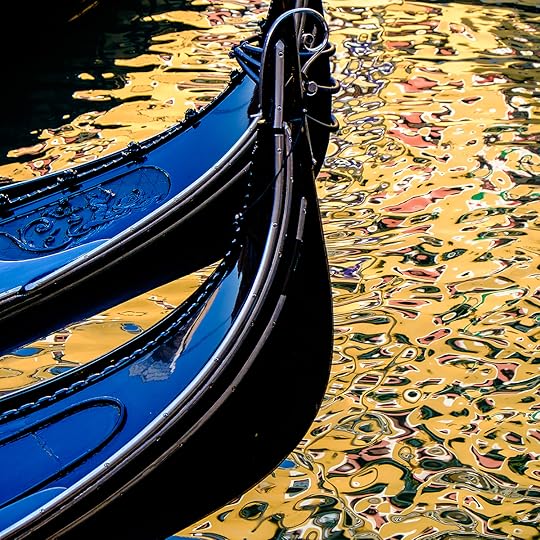Seeing Colour
This image is a photograph of two black gondolas on black water.
We do not see things as they are but as they look, and the brain will do whatever it can to untangle puzzles like this. So many people will walk past this scene and others like it and never see it. Not truly. They will see it at they think it is. Black boats on black water. But if we force our brains to look twice we see blue gondolas on a sea of yellow, red, and green, reflections from the brightly coloured hotel on the other side of the canal.

Venice, Italy. Posted twice for the sake of people getting this feed by RSS or email subscription.
The brain is what it is because of a long evolutionary process that had survival as its goal. The brain did not evolve to serve our photographic needs, nor our artistic ones. The chief creative struggle is to get the brain to work against what it has evolved to be. To overcome fear, to see things differently, to take our time, to do things that are not at all relevant to our survival as a species.
That’s why photographic seeing is so hard. It’s not about seeing at all. It’s about perception. It’s about training the brain to see what is really there, in the otherwise unimportant details. It’s about nudging the brain to think differently, to see important details in what is otherwise trivial. To allow itself to see the colours as they are and not worry about what might leap from the water. This is one reason we don’t see lamps coming out of someone’s head – we’ve seen it, judged it as unimportant and focused on other things. Same with reflections. Same with shadows. In fact almost anything we see that might be interesting photographically needs to be re-interpreted by the same brain that’s working so hard against us. It’s trying so hard to survive. We’re trying so hard to make a photograph.
So we need a firmware upgrade. And that takes time. But it can be done and the best tool for that is questions. Asking yourself to constantly re-assess what you see. What is the light really doing? Is it giving me colour I’m not seeing at first glance? Is it giving me shadows I didn’t notice? Is it creating reflections? Have you ever noticed how blue a shadow in snow can be? The more you notice these things and take note of them the more open your eyes will be, metaphorically speaking. Seeing is about recognizing. The way to do this is to keep noticing what is really there. To take notes in that brain. To remind your brain that our new priorities include the artistic and the creative. The brain is easily re-wired through repetition, it will notice new things with practice. That’s what learning to see is about. Learning to recognize what is, and helping the brain to stop interpreting things with such a “survival at all costs” paradigm.
The world our brain expects to see, and the hazards for which it looks, has been gone for most of us for a long time. If we’re going to see things as they are, and put those things into our photographs in more than an accidental way, it’s going to take a little adjustment. Ask your brain to look again. Ask more questions.
Tell Your Friends.



